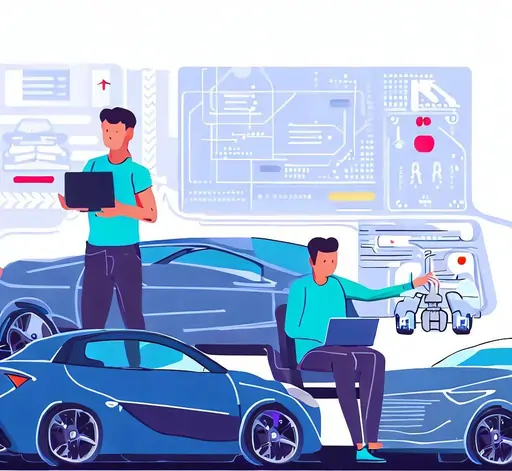Enhancing Autonomous Vehicles: Design and Simulation of Adaptive Cruise Control


Introduction to Adaptive Cruise Control
The intelligent system known as adaptive cruise control is designed to keep a safe distance between a vehicle and the one in front of it while also regulating the speed of the vehicle itself. Unlike conventional cruise control systems, which travel at a constant speed regardless of the distance or speed differential between the leading vehicle and the vehicle being followed, adaptive cruise control (ACC) automatically adjusts the vehicle's speed to keep the following distance at an appropriate level. In order to determine the distance between the current vehicle and the one that came before it, ACC uses a number of different sensors, such as radar and lidar. The control algorithm can make decisions in real time with the help of the essential information provided by these sensors.
Benefits of Adaptive Cruise Control
The implementation of Adaptive Cruise Control brings numerous benefits to both drivers and the overall transportation system. Some of the key advantages include:
- Enhanced Safety: ACC reduces the risk of rear-end collisions by continuously monitoring the distance to the preceding vehicle and applying the brakes or throttle as necessary.
- Improved Traffic Flow: By maintaining a consistent distance from the vehicle ahead, ACC helps to reduce traffic congestion and smoothen traffic flow.
- Reduced Driver Fatigue: With ACC taking care of speed control, drivers can focus more on the surrounding environment and potential hazards, leading to reduced fatigue during long drives.
Design and Simulation of Adaptive Cruise Control
To be able to create an efficient Adaptive Cruise Control (ACC) system, one must have a comprehensive understanding of the control algorithm as well as its actual application in the real world. Fortunately, engineers have access to a powerful platform in the form of MATLAB, which enables them to design, simulate, and evaluate ACC systems in a seamless manner. Engineers are able to investigate a wide variety of control algorithms, simulate real-world driving scenarios, and evaluate the performance of the system thanks to the powerful capabilities of MATLAB. Because of its intuitive interface, vast library, and cutting-edge simulation tools, MATLAB has established itself as an indispensable tool for ACC design. Engineers can improve the effectiveness and dependability of the ACC system by refining their own algorithms for the ACC, optimizing the parameters of the system, and doing all of this with the help of MATLAB and its capabilities.
- Modeling the Vehicle Dynamics
- Sensor Integration and Data Processing
- Control Algorithm Design
It is essential to develop a precise model of the vehicle's dynamics in order to simulate the behavior of an autonomous vehicle that is fitted with ACC. This model takes into account a variety of factors, including mass of the vehicle, aerodynamics, characteristics of the tires, and torque characteristics of the engine.
Engineers are able to create a dynamic model of the vehicle using the Simulink module of MATLAB. This model can represent the vehicle's response to a variety of inputs, such as commands for the accelerator, the brakes, and the steering.
The successful operation of an ACC system is heavily dependent on the integration of sensors and the processing of data from those sensors. Engineers are able to combine data from multiple sensors and obtain a more accurate representation of the environment by using the sensor fusion tools that are provided by MATLAB. These tools come in a variety of different forms.
In addition, the signal processing capabilities of MATLAB make it possible to filter, smooth, and analyze sensor data. This helps to ensure that the ACC system will function in a dependable and robust manner.
An ACC system is characterized by having a central component known as the control algorithm. MATLAB provides users with a number of control design techniques, including model-based control and reinforcement learning, which can be utilized in the process of designing an effective ACC algorithm.
The control algorithm can be developed, tested, and refined with the help of MATLAB's control system toolbox, which engineers can use. PID controllers, state-space controllers, and model predictive control are just some of the control design methods that can be found in this toolbox.
Simulation and Performance Evaluation
As soon as the Adaptive Cruise Control (ACC) system has been painstakingly designed, it is of the utmost importance to evaluate its performance in a wide variety of driving conditions and scenarios. Because it provides a robust simulation environment, MATLAB gives engineers the ability to rigorously evaluate how the ACC system behaves in a wide variety of different traffic scenarios. Engineers are able to simulate real-world driving conditions by using the simulation capabilities of MATLAB. They can then analyze how the system reacts to a variety of inputs and quantify how effective it is at keeping safe distances and maximizing vehicle speed. Engineers are able to fine-tune the ACC system thanks to this in-depth evaluation process that takes place within MATLAB. This helps to ensure that the system will perform in a dependable and effective manner while the vehicle is being driven.
- Simulating Realistic Traffic Scenarios
- Performance Metrics and Analysis
- Sensitivity Analysis and Robustness Testing
Engineers are able to create realistic traffic scenarios thanks to the simulation capabilities offered by MATLAB. These scenarios can include a variety of traffic densities, vehicle types, and road conditions. This makes it possible to conduct extensive testing and validation of the performance of the ACC system in a variety of driving environments.
Engineers can define performance metrics such as following distance, time headway, and smoothness of speed control in order to evaluate the effectiveness of the ACC system. These metrics can be computed with the help of MATLAB's data analysis tools, which also allow for the comparison of several different ACC system designs.
Additionally, the sensitivity analysis and robustness testing can be simplified within the MATLAB simulation environment. Engineers have the ability to systematically change parameters like sensor accuracy, control gains, and vehicle dynamics in order to evaluate the ACC system's robustness under a variety of circumstances.
Challenges in the Design and Implementation of Adaptive Cruise Control
The task of designing and putting into action Adaptive Cruise Control (ACC) systems for autonomous vehicles is a difficult one that comes with a variety of obstacles. Conquering these obstacles is absolutely necessary in order to guarantee the efficiency, dependability, and security of ACC systems. In this section, we will discuss some of the most significant difficulties that arose during the planning and execution of ACC, including the following:
- Sensor Fusion: It is a significant challenge to integrate data from a variety of sensors, such as radar and lidar, while maintaining accuracy and reliability in the process. The combination of data from various sensors is an extremely important step in the process of accurately detecting and following vehicles that have come before.
- Environment Perception: In order to function properly, ACC systems require accurate perception and interpretation of their surroundings. When it comes to accurately sensing and recognizing objects and obstacles, there are a number of factors that present challenges, including inclement weather, varying lighting conditions, and occlusions.
- Complex Traffic Scenarios: Situations that occur in real-world traffic can be both complicated and fluid. The ACC system needs to be able to handle a variety of scenarios, including merging lanes, passing, and interactions with pedestrians and cyclists. The creation of algorithms that are capable of effectively handling these scenarios is a difficult task.
- Control Algorithm Design: Because of the need to strike a balance between responsiveness and smoothness, developing an effective and reliable control algorithm for ACC is a challenging endeavor. The algorithm needs to make sure that acceleration and deceleration are smooth while also keeping a safe distance between the current vehicle and the one in front of it.
- Human-Machine Interaction: It is essential to ensure that there is a smooth interaction between the driver and the ACC system. The provision of a seamless and instinctive driving experience presents challenges, particularly in the areas of clear communication, feedback, and understanding the driver's intent.
- Safety Considerations: The highest priority for ACC systems should be the protection of passengers. Careful design and validation are required in order to overcome challenges associated with system fail-safe mechanisms, redundant systems, and the management of critical situations.
Advancements in Adaptive Cruise Control Techniques
To keep up with the rapid pace at which technology is advancing, researchers are investigating novel approaches to improve the functionalities of Adaptive Cruise Control (ACC) systems. These advancements are made with the intention of enhancing the functionality, adaptability, and overall efficiency of ACC in a wide variety of driving situations. In the following section, we will discuss some of the more complex methods that are utilized in ACC design:
- Machine Learning: Algorithms that use machine learning make it possible for ACC systems to learn and adapt based on the data they receive in real time. The capability of the system to anticipate and react to changes in the driving environment is improved through the use of machine learning, which works by analyzing patterns and making predictions.
- Artificial Intelligence: ACC systems are able to make intelligent decisions based on complicated inputs as a result of the incorporation of techniques from artificial intelligence. The ability of AI algorithms to process vast amounts of data enables ACC systems to more accurately and efficiently interpret and respond to changing traffic conditions.
- Predictive Modeling: ACC systems are able to anticipate the behavior of vehicles in their surroundings and make proactive adjustments because these systems make use of predictive modelling techniques. This helps to maximize speed while maintaining a safe distance, which ultimately results in driving that is more comfortable and productive.
- Sensor Fusion with Deep Learning: The ACC systems' perceptual capabilities can be significantly improved by combining various sensor fusion techniques with deep learning algorithms. ACC is able to achieve a more comprehensive understanding of the driving environment through the integration of data from multiple sensors and the utilization of deep learning models. This ultimately results in improved decision-making capabilities.
- Cooperative ACC: The capabilities of individual ACC systems can be expanded through the use of cooperative ACC because it enables communication and collaboration between vehicles. This makes it possible for cooperative maneuvers to take place, such as cooperative merging and platooning, which ultimately leads to an improvement in both the flow of traffic and overall efficiency.
Conclusion
To summaries, designing and simulating Adaptive Cruise Control (ACC) for autonomous vehicles is a challenging endeavor that calls for the careful consideration of a wide range of factors. Engineers are given the ability to effectively develop and evaluate ACC systems thanks to MATLAB's wide array of tools and capabilities, which are fortunately available to them. Engineers are able to design adaptive cruise control (ACC) systems that priorities driver safety, optimize traffic flow, and mitigate driver fatigue by utilizing the modelling, control design, and simulation capabilities offered by MATLAB. Because of its versatility, MATLAB is an invaluable platform for undergraduate students in universities. Thanks to MATLAB assignments and hands-on learning, these students can gain the practical experience and expertise necessary to develop advanced automotive technologies like ACC.